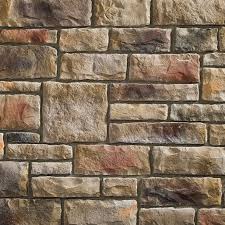 Faux Stone, Man-made Stone, Cultured Stone, and my favorite, “Lick-n-Stick Stone,” are all names for manufactured stone veneer or AMSV (applied manufactured stone veneer). Manufactured Stone Veneer is a product that looks like natural stone, but is manufactured with concrete. Today the veneer is increasing in popularity and being used to give commercial, residential, and landscape applications a rich, upscale look. The advantages of manufactured stone veneer over natural stone are: • Cost (cost of material, cost of application) • Weight (ease of application) • Variety of designs and colors • Good look for home, office, Hotel etc. Manufactured veneer is cheaper than natural stone, approximately 1/3 to 1/2 the cost of natural stone. Its lightweight eliminates the need for wall ties or footings and makes it easier and cheaper to build. The variety of designs and colors makes available options, which would not be available with natural stone, since natural stone is used in the general area around the locality, which it is extracted. There are also disadvantages for stone veneer compared to natural stone: It is not as strong as natural stone; if a piece breaks, or if a piece is removed from the wall, then unless it is replaced, it shows significantly; it is not reusable as natural stones are. Furthermore, manufactured stone veneer has a larger waste factor than natural stone. Natural stone can be chipped, cut, and shaped to any size needed. The cut off pieces can be reused. While manufactured stone veneer cannot be cut to fit because it exposes the undesirable inner concrete from which the manufactured stone is made of. I often find cut and broken pieces on new homes. Those cut or broken pieces really stick out like a red flag once you know what to look for. Manufactured stone can contain lime nuggets and iron ore, which can leech out, and stain the surface over time when exposed to water. Manufactured stone is not a naturally occurring product and, due to its cast origin and painted or dyed exterior, it is subject to color changes caused by exposure to the UV in sunlight and moisture. It is also a very labor intensive product to install, not unlike stucco. In fact I call it “Bumpy Stucco” as it is basically installed in a similar fashion. Manufactured stone is a porous product. It absorbs much more water than real stone and it will transfer the moisture through and into to the wall of the structure causing many of the same issues seen with improperly installed stucco. Being a porous product manufactured stone is subjected to ice wedging and freeze thaw problems. As water seeps into the manufactured stone and then freezes, chunks of the face will pop off leaving a rugged edge, which looks similar to the edge of a broken sidewalk. Repair can be expensive as the entire piece of stone must be cut out and replaced. The repair also doesn’t stop the issue from re-occurring. I and many other experts feel that AMSV is the next EIFS or Artificial Stucco fiasco! We are seeing more and more signs of issues with this product. If you think you have a moisture problem with your AMSV do not wait any longer. If you need a referral to an inspector in your area, I might be able to direct you to a knowledgeable person. Give me a call or email I will be glad to help if I can. |
AuthorScott Patterson has been a professional home inspector since 1995. Scott works out of the Greater Nashville TN area. Contact his team at Trace Inspections for all of your inspection needs. Archives
May 2024
|


 RSS Feed
RSS Feed